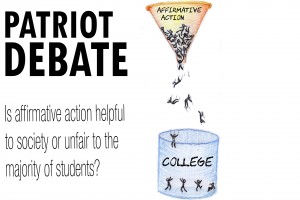Lowering standards hurts everyone
March 23, 2016
Affirmative action is not harmless. The same affirmative action that looks to help minorities puts others at a disadvantage.
Affirmative action is defined by “Merriam-Webster Dictionary” as “the practice of improving the educational and job opportunities of members of groups that have not been treated fairly in the past because of their race, sex, etc.” With that in mind, anyone interested in the college admissions process must understand this as well.
With affirmative action, schools and employers take race into consideration so that minority students are able to attend schools that would otherwise deny their admission. Universities shape their admission policies to allow for more discrete racial bias by switching to what is often called “a holistic review.”
The holistic review of the applications allows universities to justify comparing students that are like apples and oranges, then choosing whichever they like more.
While it is often argued that Caucasian applicants are negatively affected by affirmative action, representation of caucasian applicants after landmark Supreme Court cases, such as the University of California v. Bakke, suffers negligible effects. Instead, Asian applicants’ standards are dramatically increased while other minority standards are dramatically decreased.
These “mismatched” students are not only unprepared for their top-tier Ivy League schools, but they are also setting off a chain reaction of lowered standards. The better the school is, the larger the difference in the students who get in through affirmative action.
This is worrisome when studies show, for black students, SAT scores are a significantly more accurate way of predicting college GPA, which could lead to employment opportunity issues down the road.
It is gross negligence of basic human understanding for universities to admit students with dramatically lower qualifications, who they know will not do as well. The number of students accepted under affirmative action is equal to the number of more-qualified students rejected. This is true because most universities calculate the number of students they will admit based on the number of students who decided to matriculate out of the prior year’s applicants.
Affirmative action by its definition implies exceptions based on race to make up for past wrongs. To move forward and eliminate prejudices, allowing students held to lower-standards into higher institutions should not even be considered, especially because surrounding individuals with minorities who are less qualified perpetuates such prejudices. Racial exceptions in admissions through affirmative action are like saying, “Sorry we persecuted you.”
True justice can only be served by bringing up the lower class and ending prejudices. To help race equality, legislature should focus on helping the impoverished that are still affected by past and present inopportunity, not by allowing minority students an exception for diversity’s sake.
The search for a solution to racial, social, and economic equality should not begin at the college level. Real affirmative action would be implementing help to primary schools in low-income areas and enabling a better educational foundation by reinforcing a culture of learning that will promote learning even out of school and allow prejudices to die with the generation that sustained them.



